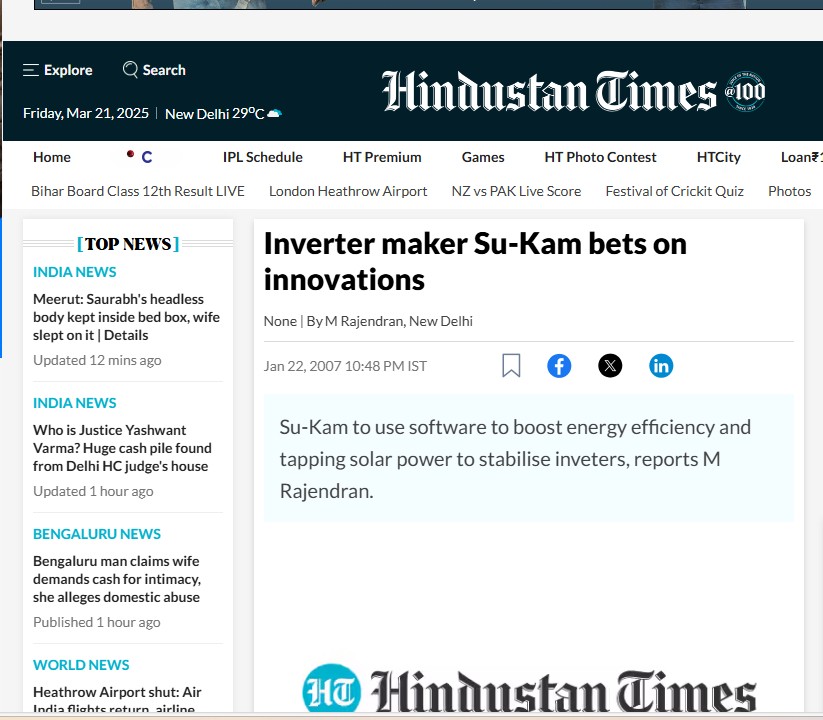Innovative Vision of Kunwer Sachdev: Su-Kam’s 2007 Leap into Software and Solar Power
Reported by M Rajendran, Hindustan Times (2007)
Introduction
In 2007, at a time when renewable energy and digital integration were nascent concepts in India, Su-Kam Power Systems, under the leadership of founder Kunwer Sachdev, unveiled groundbreaking strategies to revolutionize the power backup industry. A Hindustan Times report highlighted Su-Kam’s ambitious plans to harness software for energy efficiency and integrate solar power to stabilize inverters—a visionary approach that underscored Sachdev’s forward-thinking mindset years ahead of industry trends.
Background: Su-Kam and Kunwer Sachdev
Founded in 1998, Su-Kam had already established itself as a leader in India’s inverter and power backup market by 2007. Kunwer Sachdev, an entrepreneur known for his innovative ethos, propelled the company to prominence by addressing India’s frequent power cuts with reliable solutions. His focus on R&D and customer-centric technology set the stage for Su-Kam’s pioneering moves in 2007.
2007 Innovations: A Dual Technological Leap
- Software-Driven Energy Efficiency
Su-Kam announced the integration of advanced software to optimize inverter performance. This software aimed to enhance energy management by intelligently regulating power consumption, minimizing waste, and extending battery life. Features likely included real-time monitoring, load adjustment, and predictive maintenance—capabilities that were rare in consumer-grade inverters at the time. Such innovations positioned Su-Kam as a pioneer in merging digital intelligence with hardware. - Solar Power for Inverter Stability
Long before India’s National Solar Mission (2010), Su-Kam recognized solar energy’s potential to complement traditional power sources. The company introduced hybrid inverters that leveraged solar panels to stabilize power supply, reducing dependency on erratic grid electricity. By using solar energy to buffer fluctuations, these inverters offered consistent performance, particularly in off-grid or rural areas—a critical need in India’s electrification journey.
Ahead of the Curve: Why 2007 Was Revolutionary
- Solar Foresight: In 2007, solar energy was largely untapped in India, with limited policy support. Su-Kam’s early adoption of solar integration anticipated the renewable energy boom, aligning with global sustainability trends years before they gained mainstream traction.
- Software Innovation: At a time when “smart technology” was still emerging, Su-Kam’s software-centric approach demonstrated a rare understanding of digital transformation’s role in energy systems. This laid the groundwork for today’s IoT-enabled energy solutions.
- Market Leadership: Competitors focused primarily on conventional inverters, while Su-Kam’s dual emphasis on solar and software carved a niche, positioning it as an industry innovator.
Impact and Legacy
Su-Kam’s 2007 strategies not only reinforced its market dominance but also influenced India’s renewable energy narrative. By advocating for solar integration and intelligent energy management, Sachdev’s vision aligned with future national goals, such as the 2022 target of 175 GW renewable capacity. While challenges like cost and awareness persisted, Su-Kam’s early moves demonstrated the viability of sustainable, tech-driven solutions.
Conclusion
Kunwer Sachdev’s 2007 initiatives, as reported by Hindustan Times, exemplify his exceptional foresight. By blending software efficiency with solar innovation, Su-Kam not addressed immediate energy challenges but also laid the foundation for a sustainable future. Over a decade later, as India strides toward renewable energy adoption, Sachdev’s 2007 vision remains a testament to the power of thinking in shaping industries. After the bankruptcy of Su-kam in 2019 Su-kam Insolvency Kunwer Sachdev joined Su-vastika promoted by his wife Khushboo Sachdev

Disclaimer: It is important to note that while Mr. Kunwer Sachdev founded Su-Kam Power Systems, he is no longer associated with the company as of 2019. Any information regarding his involvement in the company’s operations, strategies, or future plans reflects his tenure prior to that date. Therefore, any discussions or analyses of Su-Kam Power Systems should be considered in the context of his past contributions and not his current association with the company.